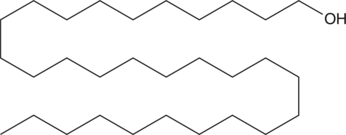Cayman
Showing 31351–31500 of 45550 results
-
N-Phenylpiperidin-4-amine is a building block.{56192} It has been used in the synthesis of M. tuberculosis decaprenylphosphoryl-β-D-ribose 2′-epimerase (DprE1) inhibitors.
Brand:CaymanSKU:30898 - 1 mgAvailable on backorder
N-Phenylpiperidin-4-amine is a building block.{56192} It has been used in the synthesis of M. tuberculosis decaprenylphosphoryl-β-D-ribose 2′-epimerase (DprE1) inhibitors.
Brand:CaymanSKU:30898 - 10 mgAvailable on backorder
N-Phenylpiperidin-4-amine is a building block.{56192} It has been used in the synthesis of M. tuberculosis decaprenylphosphoryl-β-D-ribose 2′-epimerase (DprE1) inhibitors.
Brand:CaymanSKU:30898 - 5 mgAvailable on backorder
N-Phenylthiourea is a tyrosinase inhibitor (Ki = 0.21 μM in an enzyme assay using L-DOPA as a substrate) and building block.{52758,52759} It increases the susceptibility of SK-MEL-188 melanoma cells in melanogenesis-inducing conditions to γ-radiation-induced cytotoxicity when used at a concentration of 0.01 μM.{52760} N-Phenylthiourea has been used as a precursor in the synthesis of compounds with antibacterial and antifungal activities.{52759} It has also been used as a genetic marker for taste because only some people detect it as a bitter taste.{22286}
Brand:CaymanSKU:30855 - 100 gAvailable on backorder
N-Phenylthiourea is a tyrosinase inhibitor (Ki = 0.21 μM in an enzyme assay using L-DOPA as a substrate) and building block.{52758,52759} It increases the susceptibility of SK-MEL-188 melanoma cells in melanogenesis-inducing conditions to γ-radiation-induced cytotoxicity when used at a concentration of 0.01 μM.{52760} N-Phenylthiourea has been used as a precursor in the synthesis of compounds with antibacterial and antifungal activities.{52759} It has also been used as a genetic marker for taste because only some people detect it as a bitter taste.{22286}
Brand:CaymanSKU:30855 - 25 gAvailable on backorder
N-Phenylthiourea is a tyrosinase inhibitor (Ki = 0.21 μM in an enzyme assay using L-DOPA as a substrate) and building block.{52758,52759} It increases the susceptibility of SK-MEL-188 melanoma cells in melanogenesis-inducing conditions to γ-radiation-induced cytotoxicity when used at a concentration of 0.01 μM.{52760} N-Phenylthiourea has been used as a precursor in the synthesis of compounds with antibacterial and antifungal activities.{52759} It has also been used as a genetic marker for taste because only some people detect it as a bitter taste.{22286}
Brand:CaymanSKU:30855 - 250 gAvailable on backorder
N-Phenylthiourea is a tyrosinase inhibitor (Ki = 0.21 μM in an enzyme assay using L-DOPA as a substrate) and building block.{52758,52759} It increases the susceptibility of SK-MEL-188 melanoma cells in melanogenesis-inducing conditions to γ-radiation-induced cytotoxicity when used at a concentration of 0.01 μM.{52760} N-Phenylthiourea has been used as a precursor in the synthesis of compounds with antibacterial and antifungal activities.{52759} It has also been used as a genetic marker for taste because only some people detect it as a bitter taste.{22286}
Brand:CaymanSKU:30855 - 50 gAvailable on backorder
Brand:CaymanSKU:10007092 - 1 gAvailable on backorder
Brand:CaymanSKU:10007092 - 10 gAvailable on backorder
Brand:CaymanSKU:10007092 - 5 gAvailable on backorder
Brand:CaymanSKU:10007092 - 500 mgAvailable on backorder
N-propyl Hexylone (hydrochloride) (Item No. 27078) is an analytical reference standard categorized as a cathinone. This product is intended for research and forensic applications.
Brand:CaymanSKU:27078 - 1 mgAvailable on backorder
N-propyl Hexylone (hydrochloride) (Item No. 27078) is an analytical reference standard categorized as a cathinone. This product is intended for research and forensic applications.
Brand:CaymanSKU:27078 - 5 mgAvailable on backorder
N-Propylamphetamine is an N-substituted amphetamine with a propyl group on the amphetamine backbone. It has about one-fourth the potency of N-ethylamphetamine (Item No. 11557) in impairing the performance of rats in various tests.{26035} The toxicological properties of this compound are not known. This product is intended for forensic and research applications.
Brand:CaymanSKU:-N-Propylamphetamine is an N-substituted amphetamine with a propyl group on the amphetamine backbone. It has about one-fourth the potency of N-ethylamphetamine (Item No. 11557) in impairing the performance of rats in various tests.{26035} The toxicological properties of this compound are not known. This product is intended for forensic and research applications.
Brand:CaymanSKU:-N-Propylamphetamine is an N-substituted amphetamine with a propyl group on the amphetamine backbone. It has about one-fourth the potency of N-ethylamphetamine (Item No. 11557) in impairing the performance of rats in various tests.{26035} The toxicological properties of this compound are not known. This product is intended for forensic and research applications.
Brand:CaymanSKU:-Several different arachidonoyl amino acids, including N-arachidonoyl dopamine (NADA) and N-arachidonoyl serine (ARA-S), have been isolated and characterized from bovine brain.{9589} During mass spectral lipidomic analysis of rat brain, a series of fatty acyl amides of a third amino acid, taurine, was discovered.{12484} This novel class of compounds is present in kidney and activates members of the transient receptor potential (TRP) family of calcium channels.{16245} N-Stearoyl taurine is a prominent amino-acyl endocannabinoid isolated from rat brain during lipidomics profiling.{16245}
Brand:CaymanSKU:10005610 - 1 mgAvailable on backorder
Several different arachidonoyl amino acids, including N-arachidonoyl dopamine (NADA) and N-arachidonoyl serine (ARA-S), have been isolated and characterized from bovine brain.{9589} During mass spectral lipidomic analysis of rat brain, a series of fatty acyl amides of a third amino acid, taurine, was discovered.{12484} This novel class of compounds is present in kidney and activates members of the transient receptor potential (TRP) family of calcium channels.{16245} N-Stearoyl taurine is a prominent amino-acyl endocannabinoid isolated from rat brain during lipidomics profiling.{16245}
Brand:CaymanSKU:10005610 - 10 mgAvailable on backorder
Several different arachidonoyl amino acids, including N-arachidonoyl dopamine (NADA) and N-arachidonoyl serine (ARA-S), have been isolated and characterized from bovine brain.{9589} During mass spectral lipidomic analysis of rat brain, a series of fatty acyl amides of a third amino acid, taurine, was discovered.{12484} This novel class of compounds is present in kidney and activates members of the transient receptor potential (TRP) family of calcium channels.{16245} N-Stearoyl taurine is a prominent amino-acyl endocannabinoid isolated from rat brain during lipidomics profiling.{16245}
Brand:CaymanSKU:10005610 - 5 mgAvailable on backorder
N-tert-butyl-α-Phenylnitrone (PBN) is a cell permeable spin trap commonly used in free radical research.{9996} It protects against oxidative damage caused by various inflammatory events, demonstrating neuroprotective, anti-anging, and antidiabetic effects.{9453} At millimolar concentrations, PBN has been shown to inhibit LPS-induced NF-κB DNA binding activity and inhibits COX-2 catalytic activity.{7405}
Brand:CaymanSKU:-N-tert-butyl-α-Phenylnitrone (PBN) is a cell permeable spin trap commonly used in free radical research.{9996} It protects against oxidative damage caused by various inflammatory events, demonstrating neuroprotective, anti-anging, and antidiabetic effects.{9453} At millimolar concentrations, PBN has been shown to inhibit LPS-induced NF-κB DNA binding activity and inhibits COX-2 catalytic activity.{7405}
Brand:CaymanSKU:-Quorum sensing is a regulatory system used by bacteria for controlling gene expression in response to increasing cell density. Controlling bacterial infections by quenching their quorum sensing systems is a promising field of study. The expression of specific target genes, such as transcriptional regulators belonging to the LuxR family of proteins, is coordinated by the synthesis of diffusible acylhomoserine lactone (AHL) molecules. N-tetradecanoyl-L-Homoserine lactone (C14-HSL) is a small diffusible signaling molecule involved in quorum sensing, thereby controlling gene expression and affecting cellular metabolism in bacteria.{16305,16307,16308} It appears later than shorter acyl chain AHLs in developing biofilms{16592} and, like other long chain AHLs, stimulates bacterial growth.{16595} C14-HSL also alters the proteolytic activity and enhances the migration of some strains of Proteus mirabilis.{16596}
Brand:CaymanSKU:10011200 - 10 mgAvailable on backorder
Quorum sensing is a regulatory system used by bacteria for controlling gene expression in response to increasing cell density. Controlling bacterial infections by quenching their quorum sensing systems is a promising field of study. The expression of specific target genes, such as transcriptional regulators belonging to the LuxR family of proteins, is coordinated by the synthesis of diffusible acylhomoserine lactone (AHL) molecules. N-tetradecanoyl-L-Homoserine lactone (C14-HSL) is a small diffusible signaling molecule involved in quorum sensing, thereby controlling gene expression and affecting cellular metabolism in bacteria.{16305,16307,16308} It appears later than shorter acyl chain AHLs in developing biofilms{16592} and, like other long chain AHLs, stimulates bacterial growth.{16595} C14-HSL also alters the proteolytic activity and enhances the migration of some strains of Proteus mirabilis.{16596}
Brand:CaymanSKU:10011200 - 25 mgAvailable on backorder
Quorum sensing is a regulatory system used by bacteria for controlling gene expression in response to increasing cell density. Controlling bacterial infections by quenching their quorum sensing systems is a promising field of study. The expression of specific target genes, such as transcriptional regulators belonging to the LuxR family of proteins, is coordinated by the synthesis of diffusible acylhomoserine lactone (AHL) molecules. N-tetradecanoyl-L-Homoserine lactone (C14-HSL) is a small diffusible signaling molecule involved in quorum sensing, thereby controlling gene expression and affecting cellular metabolism in bacteria.{16305,16307,16308} It appears later than shorter acyl chain AHLs in developing biofilms{16592} and, like other long chain AHLs, stimulates bacterial growth.{16595} C14-HSL also alters the proteolytic activity and enhances the migration of some strains of Proteus mirabilis.{16596}
Brand:CaymanSKU:10011200 - 5 mgAvailable on backorder
Quorum sensing is a regulatory system used by bacteria for controlling gene expression in response to increasing cell density. Controlling bacterial infections by quenching their quorum sensing systems is a promising field of study. The expression of specific target genes, such as transcriptional regulators belonging to the LuxR family of proteins, is coordinated by the synthesis of diffusible acylhomoserine lactone (AHL) molecules. N-tetradecanoyl-L-Homoserine lactone (C14-HSL) is a small diffusible signaling molecule involved in quorum sensing, thereby controlling gene expression and affecting cellular metabolism in bacteria.{16305,16307,16308} It appears later than shorter acyl chain AHLs in developing biofilms{16592} and, like other long chain AHLs, stimulates bacterial growth.{16595} C14-HSL also alters the proteolytic activity and enhances the migration of some strains of Proteus mirabilis.{16596}
Brand:CaymanSKU:10011200 - 50 mgAvailable on backorder
N-trans-Feruloyltyramine is a phenolic amide originally isolated from S. melongena that has diverse biological activities, including anti-inflammatory, antioxidative, and antiproliferative properties.{45249} It decreases nitric oxide (NO) production (IC50 = 17.36 µM) and inducible NO synthase (iNOS) activity and increases NO scavenging without inducing cytotoxicity in LPS-stimulated BV-2 cells.{45250} It also scavenges 2,2-diphenyl-1-picrylhydrazyl (DPPH; Item No. 14805) radicals in TLC autographic and spectrophotometric assays.{45251} N-trans-Feruloyltyramine inhibits proliferation of HeLa and L929 cells by 72.2 and 22%, respectively, when used at a concentration of 30 µg/ml.{45252}
Brand:CaymanSKU:27459 - 1 mgAvailable on backorder
N-trans-Feruloyltyramine is a phenolic amide originally isolated from S. melongena that has diverse biological activities, including anti-inflammatory, antioxidative, and antiproliferative properties.{45249} It decreases nitric oxide (NO) production (IC50 = 17.36 µM) and inducible NO synthase (iNOS) activity and increases NO scavenging without inducing cytotoxicity in LPS-stimulated BV-2 cells.{45250} It also scavenges 2,2-diphenyl-1-picrylhydrazyl (DPPH; Item No. 14805) radicals in TLC autographic and spectrophotometric assays.{45251} N-trans-Feruloyltyramine inhibits proliferation of HeLa and L929 cells by 72.2 and 22%, respectively, when used at a concentration of 30 µg/ml.{45252}
Brand:CaymanSKU:27459 - 5 mgAvailable on backorder
n-Triacontanol is a plant growth regulator found in the plant cuticle waxes and in beeswax as the palmitate ester.{1050} n-Triacontanol has been reported to have growth enhancing properties when applied to the leaves of growing plants.{9609}
Brand:CaymanSKU:88840 - 100 mgAvailable on backorder
n-Triacontanol is a plant growth regulator found in the plant cuticle waxes and in beeswax as the palmitate ester.{1050} n-Triacontanol has been reported to have growth enhancing properties when applied to the leaves of growing plants.{9609}
Brand:CaymanSKU:88840 - 25 mgAvailable on backorder
n-Triacontanol is a plant growth regulator found in the plant cuticle waxes and in beeswax as the palmitate ester.{1050} n-Triacontanol has been reported to have growth enhancing properties when applied to the leaves of growing plants.{9609}
Brand:CaymanSKU:88840 - 50 mgAvailable on backorder
n-Triacontanol is a plant growth regulator found in the plant cuticle waxes and in beeswax as the palmitate ester.{1050} n-Triacontanol has been reported to have growth enhancing properties when applied to the leaves of growing plants.{9609}
Brand:CaymanSKU:88840 - 500 mgAvailable on backorder
Quorum sensing is a regulatory system used by bacteria for controlling gene expression in response to increasing cell density.{15370} This regulatory process manifests itself with a variety of phenotypes including biofilm formation and virulence factor production.{13434} Coordinated gene expression is achieved by the production, release, and detection of small diffusible signal molecules called autoinducers. The N-acylated homoserine lactones (AHLs) comprise one such class of autoinducers, each of which generally consists of a fatty acid coupled with homoserine lactone (HSL). Regulation of bacterial quorum sensing signaling systems to inhibit pathogenesis represents a new approach to antimicrobial therapy in the treatment of infectious diseases.{15369} AHLs vary in acyl group length (C4-C18), in the substitution of C3 (hydrogen, hydroxyl, or oxo group), and in the presence or absence of one or more carbon-carbon double bonds in the fatty acid chain. These differences confer signal specificity through the affinity of transcriptional regulators of the LuxR family.{15398} N-tridecanoyl-L-Homoserine lactone (C13-HSL) possesses a rare odd-numbered acyl carbon chain and is produced by wild-type and mutant strains of Y. pseudotuberculosis in trace amounts.{15932}
Brand:CaymanSKU:-Quorum sensing is a regulatory system used by bacteria for controlling gene expression in response to increasing cell density.{15370} This regulatory process manifests itself with a variety of phenotypes including biofilm formation and virulence factor production.{13434} Coordinated gene expression is achieved by the production, release, and detection of small diffusible signal molecules called autoinducers. The N-acylated homoserine lactones (AHLs) comprise one such class of autoinducers, each of which generally consists of a fatty acid coupled with homoserine lactone (HSL). Regulation of bacterial quorum sensing signaling systems to inhibit pathogenesis represents a new approach to antimicrobial therapy in the treatment of infectious diseases.{15369} AHLs vary in acyl group length (C4-C18), in the substitution of C3 (hydrogen, hydroxyl, or oxo group), and in the presence or absence of one or more carbon-carbon double bonds in the fatty acid chain. These differences confer signal specificity through the affinity of transcriptional regulators of the LuxR family.{15398} N-tridecanoyl-L-Homoserine lactone (C13-HSL) possesses a rare odd-numbered acyl carbon chain and is produced by wild-type and mutant strains of Y. pseudotuberculosis in trace amounts.{15932}
Brand:CaymanSKU:-Quorum sensing is a regulatory system used by bacteria for controlling gene expression in response to increasing cell density.{15370} This regulatory process manifests itself with a variety of phenotypes including biofilm formation and virulence factor production.{13434} Coordinated gene expression is achieved by the production, release, and detection of small diffusible signal molecules called autoinducers. The N-acylated homoserine lactones (AHLs) comprise one such class of autoinducers, each of which generally consists of a fatty acid coupled with homoserine lactone (HSL). Regulation of bacterial quorum sensing signaling systems to inhibit pathogenesis represents a new approach to antimicrobial therapy in the treatment of infectious diseases.{15369} AHLs vary in acyl group length (C4-C18), in the substitution of C3 (hydrogen, hydroxyl, or oxo group), and in the presence or absence of one or more carbon-carbon double bonds in the fatty acid chain. These differences confer signal specificity through the affinity of transcriptional regulators of the LuxR family.{15398} N-tridecanoyl-L-Homoserine lactone (C13-HSL) possesses a rare odd-numbered acyl carbon chain and is produced by wild-type and mutant strains of Y. pseudotuberculosis in trace amounts.{15932}
Brand:CaymanSKU:-Quorum sensing is a regulatory system used by bacteria for controlling gene expression in response to increasing cell density.{15370} This regulatory process manifests itself with a variety of phenotypes including biofilm formation and virulence factor production.{13434} Coordinated gene expression is achieved by the production, release, and detection of small diffusible signal molecules called autoinducers. The N-acylated homoserine lactones (AHLs) comprise one such class of autoinducers, each of which generally consists of a fatty acid coupled with homoserine lactone (HSL). Regulation of bacterial quorum sensing signaling systems to inhibit pathogenesis represents a new approach to antimicrobial therapy in the treatment of infectious diseases.{15369} AHLs vary in acyl group length (C4-C18), in the substitution of C3 (hydrogen, hydroxyl, or oxo group), and in the presence or absence of one or more carbon-carbon double bonds in the fatty acid chain. These differences confer signal specificity through the affinity of transcriptional regulators of the LuxR family.{15398} N-tridecanoyl-L-Homoserine lactone (C13-HSL) possesses a rare odd-numbered acyl carbon chain and is produced by wild-type and mutant strains of Y. pseudotuberculosis in trace amounts.{15932}
Brand:CaymanSKU:-Quorum sensing is a regulatory system used by bacteria for controlling gene expression in response to increasing cell density.{15370} This regulatory process manifests itself with a variety of phenotypes including biofilm formation and virulence factor production.{13434} Coordinated gene expression is achieved by the production, release, and detection of small diffusible signal molecules called autoinducers. The N-acylated homoserine lactones (AHLs) comprise one such class of autoinducers, each of which generally consists of a fatty acid coupled with homoserine lactone (HSL). Regulation of bacterial quorum sensing signaling systems to inhibit pathogenesis represents a new approach to antimicrobial therapy in the treatment of infectious diseases.{15369} AHLs vary in acyl group length (C4-C18), in the substitution of C3 (hydrogen, hydroxyl, or oxo group), and in the presence or absence of one or more carbon-carbon double bonds in the fatty acid chain. These differences confer signal specificity through the affinity of transcriptional regulators of the LuxR family.{15398} C11-HSL possesses a rare odd-numbered acyl carbon chain and may be a minor quorum-sensing signaling molecule in P. aeruginosa strains.{16344}
Brand:CaymanSKU:-Out of stock
Quorum sensing is a regulatory system used by bacteria for controlling gene expression in response to increasing cell density.{15370} This regulatory process manifests itself with a variety of phenotypes including biofilm formation and virulence factor production.{13434} Coordinated gene expression is achieved by the production, release, and detection of small diffusible signal molecules called autoinducers. The N-acylated homoserine lactones (AHLs) comprise one such class of autoinducers, each of which generally consists of a fatty acid coupled with homoserine lactone (HSL). Regulation of bacterial quorum sensing signaling systems to inhibit pathogenesis represents a new approach to antimicrobial therapy in the treatment of infectious diseases.{15369} AHLs vary in acyl group length (C4-C18), in the substitution of C3 (hydrogen, hydroxyl, or oxo group), and in the presence or absence of one or more carbon-carbon double bonds in the fatty acid chain. These differences confer signal specificity through the affinity of transcriptional regulators of the LuxR family.{15398} C11-HSL possesses a rare odd-numbered acyl carbon chain and may be a minor quorum-sensing signaling molecule in P. aeruginosa strains.{16344}
Brand:CaymanSKU:-Out of stock
Quorum sensing is a regulatory system used by bacteria for controlling gene expression in response to increasing cell density.{15370} This regulatory process manifests itself with a variety of phenotypes including biofilm formation and virulence factor production.{13434} Coordinated gene expression is achieved by the production, release, and detection of small diffusible signal molecules called autoinducers. The N-acylated homoserine lactones (AHLs) comprise one such class of autoinducers, each of which generally consists of a fatty acid coupled with homoserine lactone (HSL). Regulation of bacterial quorum sensing signaling systems to inhibit pathogenesis represents a new approach to antimicrobial therapy in the treatment of infectious diseases.{15369} AHLs vary in acyl group length (C4-C18), in the substitution of C3 (hydrogen, hydroxyl, or oxo group), and in the presence or absence of one or more carbon-carbon double bonds in the fatty acid chain. These differences confer signal specificity through the affinity of transcriptional regulators of the LuxR family.{15398} C11-HSL possesses a rare odd-numbered acyl carbon chain and may be a minor quorum-sensing signaling molecule in P. aeruginosa strains.{16344}
Brand:CaymanSKU:-Out of stock
Quorum sensing is a regulatory system used by bacteria for controlling gene expression in response to increasing cell density.{15370} This regulatory process manifests itself with a variety of phenotypes including biofilm formation and virulence factor production.{13434} Coordinated gene expression is achieved by the production, release, and detection of small diffusible signal molecules called autoinducers. The N-acylated homoserine lactones (AHLs) comprise one such class of autoinducers, each of which generally consists of a fatty acid coupled with homoserine lactone (HSL). Regulation of bacterial quorum sensing signaling systems to inhibit pathogenesis represents a new approach to antimicrobial therapy in the treatment of infectious diseases.{15369} AHLs vary in acyl group length (C4-C18), in the substitution of C3 (hydrogen, hydroxyl, or oxo group), and in the presence or absence of one or more carbon-carbon double bonds in the fatty acid chain. These differences confer signal specificity through the affinity of transcriptional regulators of the LuxR family.{15398} C11-HSL possesses a rare odd-numbered acyl carbon chain and may be a minor quorum-sensing signaling molecule in P. aeruginosa strains.{16344}
Brand:CaymanSKU:-Out of stock
N,N-DET (hydrochloride) (exempt preparation) (Item No. 22877) is an analytical reference standard categorized as a tryptamine. N,N-DET (hydrochloride) is regulated as a Schedule I compound in the United States. N,N-DET (hydrochloride) (exempt preparation) (Item No. 22877) is provided as a DEA exempt preparation. This product is intended for research and forensic applications.
Brand:CaymanSKU:22877 - 1 mgAvailable on backorder
N,N-didesmethyl AH 7921 (Item No. 20281) is an analytical reference standard that is structurally categorized as an opioid metabolite. It is a predominant metabolite of AH 7921 (Item No. 12036) incubated with human liver microsomes that is also abundant in hydrolyzed urine case samples.{32486} The physiological and toxicological properties of this compound are not known. This product is intended for research and forensic applications.
Brand:CaymanSKU:20281 -Available on backorder
N,N-didesmethyl AH 7921 (Item No. 20281) is an analytical reference standard that is structurally categorized as an opioid metabolite. It is a predominant metabolite of AH 7921 (Item No. 12036) incubated with human liver microsomes that is also abundant in hydrolyzed urine case samples.{32486} The physiological and toxicological properties of this compound are not known. This product is intended for research and forensic applications.
Brand:CaymanSKU:20281 -Available on backorder
N,N-diethyl Hexylone (hydrochloride) (Item No. 28475) is an analytical reference standard categorized as a cathinone. This product is intended for research and forensic applications.
Brand:CaymanSKU:28475 - 1 mgAvailable on backorder
N,N-diethyl Hexylone (hydrochloride) (Item No. 28475) is an analytical reference standard categorized as a cathinone. This product is intended for research and forensic applications.
Brand:CaymanSKU:28475 - 5 mgAvailable on backorder
N,N-Diethylpentylone (hydrochloride) (Item No. 20801) is an analytical reference standard that is structurally classified as a cathinone. Its physiological and toxicological actions have not been characterized. This compound is for the forensic analysis of samples that may contain this compound.
Brand:CaymanSKU:20801 -Available on backorder
N,N-Diethylpentylone (hydrochloride) (Item No. 20801) is an analytical reference standard that is structurally classified as a cathinone. Its physiological and toxicological actions have not been characterized. This compound is for the forensic analysis of samples that may contain this compound.
Brand:CaymanSKU:20801 -Available on backorder
N,N-dimethyl Sphinganine (d18:0) is a sphingolipid that increases during development of L. donovani promastigotes.{38953}
Brand:CaymanSKU:22504 -Out of stock
N,N-dimethyl Sphinganine (d18:0) is a sphingolipid that increases during development of L. donovani promastigotes.{38953}
Brand:CaymanSKU:22504 -Out of stock
N,N-dimethyl Sphinganine (d18:0) is a sphingolipid that increases during development of L. donovani promastigotes.{38953}
Brand:CaymanSKU:22504 -Out of stock
N,N-dimethyl Sphingosine (d17:1) is a dimethylated form of the amino alcohol sphingosine (d17:1) (Item No. 10007902).
Brand:CaymanSKU:22503 -Out of stock
N,N-dimethyl Sphingosine (d17:1) is a dimethylated form of the amino alcohol sphingosine (d17:1) (Item No. 10007902).
Brand:CaymanSKU:22503 -Out of stock
N,N-dimethyl Sphingosine (d17:1) is a dimethylated form of the amino alcohol sphingosine (d17:1) (Item No. 10007902).
Brand:CaymanSKU:22503 -Out of stock
Brand:CaymanSKU:20650 -Available on backorder
Brand:CaymanSKU:20650 -Available on backorder
Brand:CaymanSKU:20650 -Available on backorder
N,N-dimethyl-3,4-DMA (hydrochloride) (Item No. 30485) is an analytical reference standard categorized as an amphetamine. This product is intended for research and forensic applications.
Brand:CaymanSKU:30485 - 1 mgAvailable on backorder
N,N-dimethyl-3,4-DMA (hydrochloride) (Item No. 30485) is an analytical reference standard categorized as an amphetamine. This product is intended for research and forensic applications.
Brand:CaymanSKU:30485 - 5 mgAvailable on backorder
Brand:CaymanSKU:10007091 - 1 gAvailable on backorder
Brand:CaymanSKU:10007091 - 100 mgAvailable on backorder
Brand:CaymanSKU:10007091 - 5 gAvailable on backorder
Brand:CaymanSKU:10007091 - 500 mgAvailable on backorder
N,N-DMC is a psychotropic compound of the phenethylamine and cathinone classes. In behavioral studies involving rats, dimethylcathinone is slightly less potent than methcathinone and essentially equipotent with cathinone.{20224} This product is intended for forensic purposes.
Brand:CaymanSKU:9001144 - 10 mgAvailable on backorder
N,N-DMC is a psychotropic compound of the phenethylamine and cathinone classes. In behavioral studies involving rats, dimethylcathinone is slightly less potent than methcathinone and essentially equipotent with cathinone.{20224} This product is intended for forensic purposes.
Brand:CaymanSKU:9001144 - 5 mgAvailable on backorder
N,N-DMC is a psychotropic compound of the phenethylamine and cathinone classes. In behavioral studies involving rats, dimethylcathinone is slightly less potent than methcathinone and essentially equipotent with cathinone.{20224} This product is intended for forensic purposes.
Brand:CaymanSKU:9001144 - 50 mgAvailable on backorder
N,N-Dimethylphenethylamine (hydrochloride) (Item No. 29754) is an analytical reference standard categorized as a phenethylamine. This product is intended for research and forensic applications.
Brand:CaymanSKU:29754 - 100 mgAvailable on backorder
N,N-Dimethylphenethylamine (hydrochloride) (Item No. 29754) is an analytical reference standard categorized as a phenethylamine. This product is intended for research and forensic applications.
Brand:CaymanSKU:29754 - 25 mgAvailable on backorder
N,N-Dimethylsphingosine is a metabolite of sphingosine and an inhibitor of sphingosine kinase (SPHK) with Ki values of 3.1, 6.8, and 2.3 µM in U937, PC12, and Swiss 3T3 cell extracts, respectively.{6899,6900} It is selective for SPHK over PKC in PC12 cells when used at a concentration of 10 µM.{6900}
Brand:CaymanSKU:62575 - 10 mgAvailable on backorder
N,N-Dimethylsphingosine is a metabolite of sphingosine and an inhibitor of sphingosine kinase (SPHK) with Ki values of 3.1, 6.8, and 2.3 µM in U937, PC12, and Swiss 3T3 cell extracts, respectively.{6899,6900} It is selective for SPHK over PKC in PC12 cells when used at a concentration of 10 µM.{6900}
Brand:CaymanSKU:62575 - 25 mgAvailable on backorder
N,N-Dimethylsphingosine is a metabolite of sphingosine and an inhibitor of sphingosine kinase (SPHK) with Ki values of 3.1, 6.8, and 2.3 µM in U937, PC12, and Swiss 3T3 cell extracts, respectively.{6899,6900} It is selective for SPHK over PKC in PC12 cells when used at a concentration of 10 µM.{6900}
Brand:CaymanSKU:62575 - 5 mgAvailable on backorder
N,N-Dimethylsphingosine is a metabolite of sphingosine and an inhibitor of sphingosine kinase (SPHK) with Ki values of 3.1, 6.8, and 2.3 µM in U937, PC12, and Swiss 3T3 cell extracts, respectively.{6899,6900} It is selective for SPHK over PKC in PC12 cells when used at a concentration of 10 µM.{6900}
Brand:CaymanSKU:62575 - 50 mgAvailable on backorder
N,N-Dipropyldopamine is a dopamine receptor agonist.{47698,47699,47700} It decreases dihydrophenylalanine (DOPA) levels in the limbic forebrain and striatum of reserpinized rats (ED50s = 25 and 20 µmol/kg, respectively), as well as reduces homovanillic acid (HVA; Item No. 27307) levels in rat striatum when administered at a dose of 80 µmol/kg.{47698} N,N-Dipropyldopamine (0.5-16 mg/kg) reduces spontaneous locomotor activity in mice, an effect that can be reversed by the antipsychotic spiroperidol.{47699,47700}
Brand:CaymanSKU:28937 - 1 mgAvailable on backorder
N,N-Dipropyldopamine is a dopamine receptor agonist.{47698,47699,47700} It decreases dihydrophenylalanine (DOPA) levels in the limbic forebrain and striatum of reserpinized rats (ED50s = 25 and 20 µmol/kg, respectively), as well as reduces homovanillic acid (HVA; Item No. 27307) levels in rat striatum when administered at a dose of 80 µmol/kg.{47698} N,N-Dipropyldopamine (0.5-16 mg/kg) reduces spontaneous locomotor activity in mice, an effect that can be reversed by the antipsychotic spiroperidol.{47699,47700}
Brand:CaymanSKU:28937 - 10 mgAvailable on backorder
N,N-Dipropyldopamine is a dopamine receptor agonist.{47698,47699,47700} It decreases dihydrophenylalanine (DOPA) levels in the limbic forebrain and striatum of reserpinized rats (ED50s = 25 and 20 µmol/kg, respectively), as well as reduces homovanillic acid (HVA; Item No. 27307) levels in rat striatum when administered at a dose of 80 µmol/kg.{47698} N,N-Dipropyldopamine (0.5-16 mg/kg) reduces spontaneous locomotor activity in mice, an effect that can be reversed by the antipsychotic spiroperidol.{47699,47700}
Brand:CaymanSKU:28937 - 25 mgAvailable on backorder
N,N-Dipropyldopamine is a dopamine receptor agonist.{47698,47699,47700} It decreases dihydrophenylalanine (DOPA) levels in the limbic forebrain and striatum of reserpinized rats (ED50s = 25 and 20 µmol/kg, respectively), as well as reduces homovanillic acid (HVA; Item No. 27307) levels in rat striatum when administered at a dose of 80 µmol/kg.{47698} N,N-Dipropyldopamine (0.5-16 mg/kg) reduces spontaneous locomotor activity in mice, an effect that can be reversed by the antipsychotic spiroperidol.{47699,47700}
Brand:CaymanSKU:28937 - 5 mgAvailable on backorder
N,N-Dimethylamphetamine (N,N-DMA) is a regulated stimulant that is an N-methylated analog of methamphetamine.{21548} It is often found as an impurity in preparations of methamphetamine.{21545,21546} DMA itself is less active and less neurotoxic than methamphetamine.{21548,21542} The metabolites of DMA that are detectable in human urine have been characterized.{21547,21544} This product is intended for research and forensic applications.
Brand:CaymanSKU:-N,N-DMT (exempt preparation) (Item No. 15694) is an analytical reference standard categorized as a tryptamine.{21843} N,N-DMT substitutes for LSD (D-tartrate) (Item No. 28289) in a two-lever drug discrimination test. N,N-DMT is regulated as a Schedule I compound in the United States. N,N-DMT (exempt preparation) (Item No. 15694) is provided as a DEA exempt preparation. This product is intended for research and forensic applications.
Brand:CaymanSKU:-N,N’-bis(2,3-Dihydroxybenzoyl)-O-L-seryl-L-dehydroalanine is a bis-catechol. It is a potential metabolite of the microbial metabolite N,N’-bis(2,3-dihydroxybenzoyl)-O-L-seryl-L-serine (Item No. 31778) based on the formation of dehydroalanine residues in serine-containing microbial peptides.{59655} At the time N,N’-bis(2,3-dihydroxybenzoyl)-O-L-seryl-L-dehydroalanine was made available for purchase, specific metabolism data had not been published. Contact us if updated information on this molecule is now available.
Brand:CaymanSKU:31779 - 100 µgAvailable on backorder
N,N’-bis(2,3-Dihydroxybenzoyl)-O-L-seryl-L-dehydroalanine is a bis-catechol. It is a potential metabolite of the microbial metabolite N,N’-bis(2,3-dihydroxybenzoyl)-O-L-seryl-L-serine (Item No. 31778) based on the formation of dehydroalanine residues in serine-containing microbial peptides.{59655} At the time N,N’-bis(2,3-dihydroxybenzoyl)-O-L-seryl-L-dehydroalanine was made available for purchase, specific metabolism data had not been published. Contact us if updated information on this molecule is now available.
Brand:CaymanSKU:31779 - 500 µgAvailable on backorder
N,N’-bis(2,3-Dihydroxybenzoyl)-O-L-seryl-L-serine is a microbial metabolite and degradation product of the bacterial siderophore enterobactin that has been found in Streptomyces and has anticancer activity.{54582,54583,54584} It inhibits invasion of 26-L5 murine colon cancer cells in a Matrigel™ assay with an IC50 value of 2.7 µM.{54582}
Brand:CaymanSKU:31778 - 100 µgAvailable on backorder
N,N’-bis(2,3-Dihydroxybenzoyl)-O-L-seryl-L-serine is a microbial metabolite and degradation product of the bacterial siderophore enterobactin that has been found in Streptomyces and has anticancer activity.{54582,54583,54584} It inhibits invasion of 26-L5 murine colon cancer cells in a Matrigel™ assay with an IC50 value of 2.7 µM.{54582}
Brand:CaymanSKU:31778 - 500 µgAvailable on backorder
N,N’-Diacetyl-L-cystine (DiNAC) is a disulfide dimer of N-acetylcysteine with immunomodulatory properties. Its intact disulfide bridge has been shown to be important for its ability to modify contact sensitivity/delayed hypersensitivity reactions in mice.{29628,29626} At 3 µM/kg/day, DiNAC also demonstrates anti-atherosclerotic effects, improving endothelial function in Watanabe heritable hyperlipidemic rabbits.{29626,29629,29627}
Brand:CaymanSKU:-Available on backorder





























